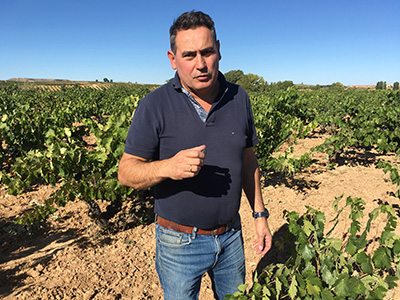Vizcarra
Finca Chirri, s/n. 09317 Mambrilla de Castrejón (Burgos), 09317, Mambrilla de Castrejón, Burgos, Spain
www.vizcarra.es
Founded by Juan Carlos Vizcarra and his wife in 1991, this is a family winery that started producing wine with the vineyards planted in the 1980s by José Manuel, Juan Carlos’s father. “My first wines were made in a garage; that’s why I had very clear ideas about my needs when we built the winery in 2006,” Juan Carlos explains.
Vizcarra sources grapes from 50Ha of vineyards in the villages of Mambrilla de Castrejón, where the winery stands, and Roa (both of them in the province of Burgos). Around 30 of them are their own; the rest are rented and they also buy fruit from local grape growers. There are 15Ha surrounding the winery. The highest part is Finca Chirri, an experimental vineyard with trellised vines where different clones of Tempranillo can be found.
Soils are mainly gravely or limestone. The poorest areas are dominated by head-pruned vines. Tempranillo, locally called Tinto Fino, is the dominant grape but Vizcarra also makes a delicious Garnacha (€23) sold with the VT Castilla y León seal as this variety is not authorized as a single-varietal in Ribera del Duero. Juan Carlos planted a vineyard with Garnacha using plant material from Celia, a vineyard named after one of his children -in fact, his top reds are named after his two daughters: Celia and Inés.
Vizcarra handles around 400,000 kg of grapes on an annual basis. The range starts with a couple of outstanding value reds: Senda del Oro (150,000 bottles, around €9) and Vizcarra 15 meses (around 60,000-70,000 bottles, €15, 15 months in barrel), both of which carry a generic back label. Grapes for Vizcarra are mainly sourced from vineyards planted by Juan Carlos’s father which are now over 20 years. When the top reds don’t reach the necessary quality, their grapes are usually blended in here.
Prior to fermentation, grapes are cold-macerated around three to four days using stainless steel tanks with cooling jackets or dry ice. Crane-operated tanks are employed to handle grapes softly. Extraction is usually achieved by combining délestage and pump-overs among other techniques.
The premium range features three single-varietal reds. Made from 80-year-old vines, Torralvo (around 6,500 bottles, €35) is fermented in concrete tanks and aged in French oak for 18 months. Concrete is widely used at Vizcarra for malolactic fermentations, clarifications and to oxygenate wines that feel closed after having been kept in stainless-steel tanks.
As for the wines bearing the names of Juan Carlos’ daughters, Celia is made from a 55-year-old vineyard planted with Tempranillo and 5% Garnacha, while grapes for Inés are sourced from a Tempranillo plot planted around 1945 plus 10% Merlot from younger vines. Production doesn’t exceed 2,000 bottles in any of these two wines and retail prices stand at around €60. Fermentation takes place in open barrels in what Juan Carlos calls his “micro-winery”, a experimental area for his Garnacha and for the rest of his top old-vine wines.
Vizcarra exports 40% of its wines. Imported by Olé Imports, the US is its main market. “Our aim is to improve our positioning and grow with our special wines, but this is a hard, slow task,” Juan Carlos says. His daughter Celia, a trained winemaker with overseas harvesting experience, has recently joined the business.
Most popular
NEWSLETTER
Join our community of Spanish wine lovers


